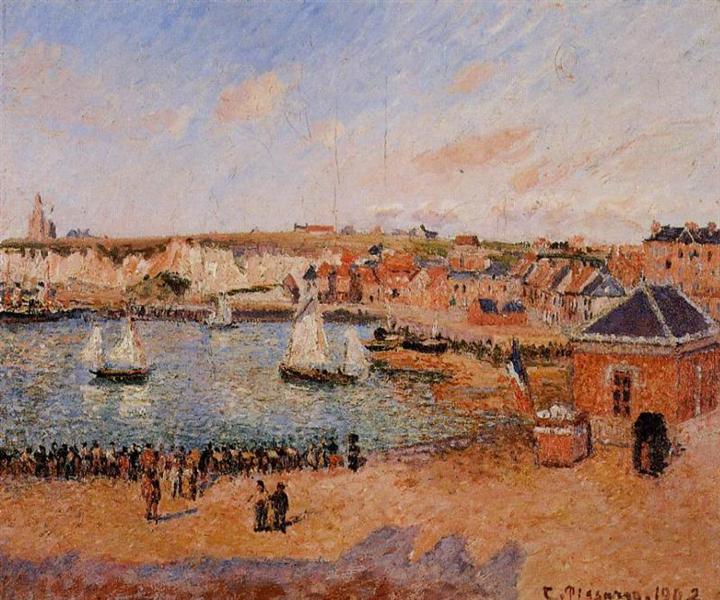Beskrivelse
Camille Pissarro, a central figure of Impressionism and a precursor of Neo-Impressionism, offers us in "The Inner Harbour - Afternoon at Dieppe - Sun - Low Tide" from 1902 a vibrant representation of everyday life and the connection between man and nature. This work, which shows the port of Dieppe at a time of low tide, encapsulates a unique serenity that can be appreciated in the placid atmosphere of the place, achieved through his characteristic use of colour and light.
The painting is articulated around a balanced composition that shows a panoramic view of the port. In the foreground, the water is shown at a low level, revealing the texture of the seabed and creating a mirror that subtly reflects the hues of the sky. The boats, anchored and devoid of activity, add a sense of calm, but also an echo of daily life that at this moment seems suspended. Pissarro, faithful to his style, uses loose and dynamic brushstrokes that bring movement and life to the scene, allowing the viewer to feel the soft breeze of the port.
The masterfully chosen colours vary in a palette of mainly blues, greens and ochres that come together to create a warm and welcoming atmosphere, typical of a sunny afternoon. Light becomes the protagonist of the work; its careful calculation highlights the effects of the sun on the different surfaces, from the sand to the blankets of the boats, generating a play of shadows that enriches the dimensionality. This luminous representation is a distinctive sign of Impressionism, where the focus falls on the artist's visual perception at a given moment.
In the distance, the houses of Dieppe line the background, providing a sense of place and community, while in the foreground, two human figures appear to subtly interact with the environment, perhaps checking nets or preparing boats. These figures, while not the focus of attention, contribute to the narrative of a life that is intertwined with the natural environment, reinforcing the bond between humanity and its surroundings.
Pissarro was an innovator not only in his technique, but also in his commitment to the depiction of landscape. Through works such as this, he was making a point about the importance of the natural world in modern life. The choice of Dieppe, a traditional fishing port, indicates a sympathy for mundane practices and environments that other contemporaries might have overlooked in their pursuit of grander subjects.
Pissarro's work, in addition to capturing the light and colour of an afternoon on the Normandy coast, also fits into a broader context of Impressionist exploration. It shares thematic similarities with other works by his contemporaries, such as Monet and Renoir, who also sought in nature and everyday life the ephemeral essence of time. However, Pissarro's approach to the representation of space and time often reflects a concern with modernity and rural life that differs from his peers.
In conclusion, “The Inner Harbour - Afternoon at Dieppe - Sun - Low Tide” is not only an extraordinary example of Pissarro’s artistic mastery, but is also a meditation on the relationship between man and his environment. The combination of light, colour and form come together to create a work that transcends mere representation, inviting the viewer to contemplate the beauty in the everyday and to remember the fragility of the moments we capture with our gaze. This painting is therefore a testament to Pissarro’s ability to transform the visual experience into a deep emotional connection.
KUADROS ©, a famous painting on your wall.
Hand-made oil painting reproductions, with the quality of professional artists and the distinctive seal of KUADROS ©.
Painting reproduction service with satisfaction guarantee. If you are not completely satisfied with the replica of your painting, we will refund 100% of your money.

